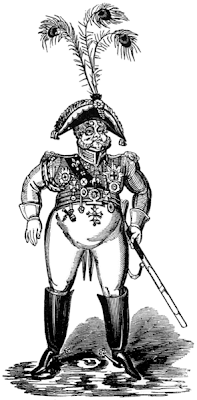
Happier times for Franz Ferdinand at the peak of archducal fashion with a head-
mounted Vesuvius
Franz Ferdinand rightly gets a lot of notoriety for his assassination as the spark that set off the First World War, but the man he was supposed to replace as heir to the Austrian Empire had an interesting close shave. In 1853, Franz Joseph was strolling with the impossibly-named Maximilian Karl Lamoral Graf O’Donnell von Tyrconnell when a Hungarian nationalist named János Libényi attempted the classic neckstab. Fortunately, Franz Josef was sporting a collar stiff enough to blunt the force of the attack, allowing von Tyrconnell to subdue Libényi with the ceremonial saber he had carried around for hitherto no reason. This was the second time that aristocratic accessories had saved a European aristocrat after an assassin got tangled up in one of Charles X's epaulets.

In this lithograph, Franz Josef is taken by surprise when The Penguin unleashes
Libényi, whom he had cleverly concealed in his overcoat
The Big Ten Network predictably breaks out the price of gas and milk from the last time the 'Cats beat Indiana, as well as the fact that anyone who wanted to talk to the president got a face full of the Johnson treatment.

Johnson intimidated and cajoled allies and antagonists
through flattery, threats, and by lunging at them to
display his eye spots. In a pinch, Johnson could also
secrete a psychotropic toxin secreted through his his
massive forehead
The LBJ Presidential Library in Austin is worth visiting merely for the animatronic talking LBJ on the second floor, which spins homespun tales of wisdom while gesticulating in a creepy manner, making the effect a cross between a museum exhibit and a Country Bear Jamboroo. There's video of it here, but the LBJ Library website does not mention the Quagmire ball pit located immediately next door.
MONKEY ASSAULT
The big win over Indiana comes at the expense of a once-proud program that is currently the Washington Generals of the Big Ten. And therefore, the win is less exciting than it would have been if Bobby Knight had been prowling the sidelines and nervously strangling freshmen. So BYCTOM turns its attention to far more pressing matters: violence and monkeys. The New York Times ran a fascinating article enigmatically entitled "My Monkey, My Self" which profiles a number of people who own monkeys or chimps as pets and what happens when the monkeys inevitably try to kill them. Compare these passages, for example:
“He’s very beguiling,” Bob says. “He puts his hand out, looks at you with those beautiful brown eyes, and you feel compelled to hold hands.”
"On one occasion, they got in a wrestling match, and Higgins put one of his “steel-like fingernails” through Bob’s scrotum."
The best thing about the article is how quickly monkey owners call for lethal violence when their pets try to kill them.
Once, when Bob was leading him from an outdoor enclosure back to his cage in the house, Higgins exploded and the two got into a battle so ferocious that despite the steel mesh glove Bob was wearing, he screamed for Carlie to get his .22 rifle and put a bullet in Higgins’s head. She got Higgins a slice of raisin bread instead, quickly defusing the fight.
and
“He started biting and screaming at me, biting any place he could touch. It was a nightmare. We tipped over furniture, I would have killed him if I could. But he was so strong. I tried to choke him to make him stop. We fought for I don’t know how long. I was trying to hold him so he couldn’t bite me. I took one of my big fabric books and held it on his throat.”

Monkeys and apes occasionally turn their
inherent trucker clobbering powers against
their hapless owners
The ferocity of monkeys has led to the phenomenon of French gangs using them as attack animals. A 2000 article in the Guardian noted that the crackdown on pit bulls and dobermans has led to a popularity of Barbary Apes as fighting animals and occasional debt collectors:
"They live naturally on rocks or in a desert environment," said Marie-Claude Bomsel of the natural history museum in Paris. "Removed from their natural habitat, they can become highly aggressive. They bite, and their favoured method of attack is to hurl themselves at people's heads."


The barbary ape displays its primary weapons: sharp incisors and due process,
damned, stinking, rotten due process
More worryingly, monkeys have now gone after politicians. I'll allow the lead from this BBC article to explain it for more articulately than I can: "The deputy mayor of the Indian capital Delhi has died a day after being attacked by a horde of wild monkeys. SS Bajwa suffered serious head injuries when he fell from the first-floor terrace of his home on Saturday morning trying to fight off the monkeys." Obviously, monkey assassinations may be the opening salvo in a chilling bid for political power.

From the heights of these pyramids,
forty centuries look down on us
One famous napoleonically dressed monkey legend involves the Hartlepool Monkey where British fishermen in the town of Hartlepool found a monkey in French military garb that washed up from a shipwreck. They accused the monkey of being a spy, tried it for treason, and festively hanged it, inspiring a poem and the sports teams known as the "Monkey Hangers."

The Man in the Yellow Hat doesn't cotton to Bonapartistes
Essentially, monkeys are furry time bombs, just waiting to turn from cuddly primate into an aggressive buzzsaw of fangs and claws. And those are just domestic monkeys. In the wild, they are more of a force to be reckoned with:











































